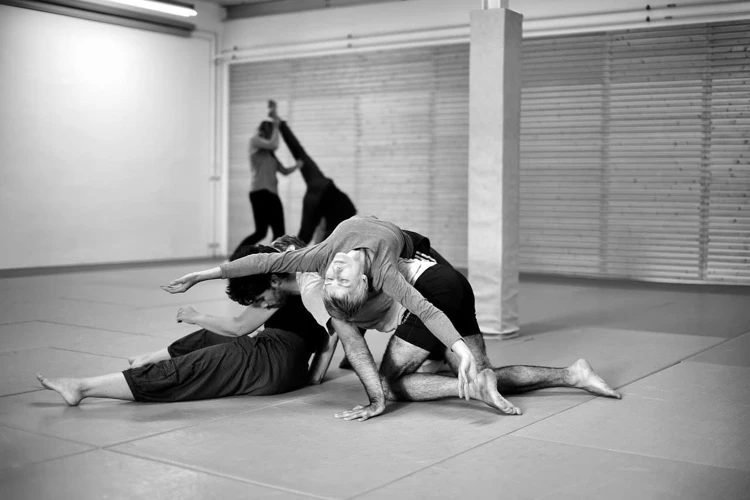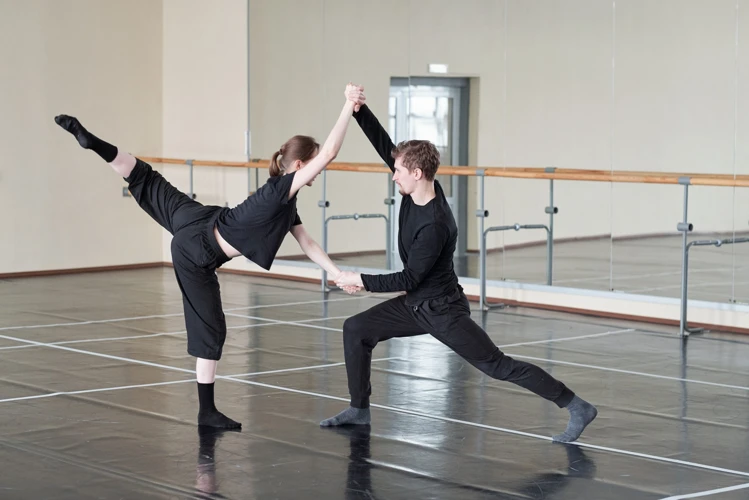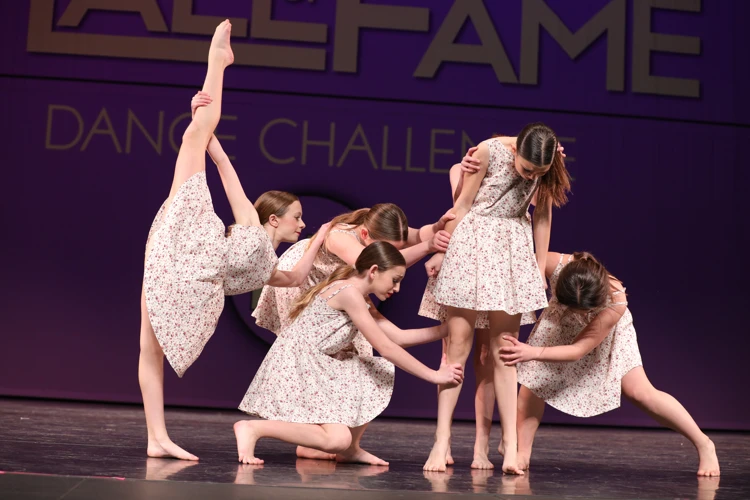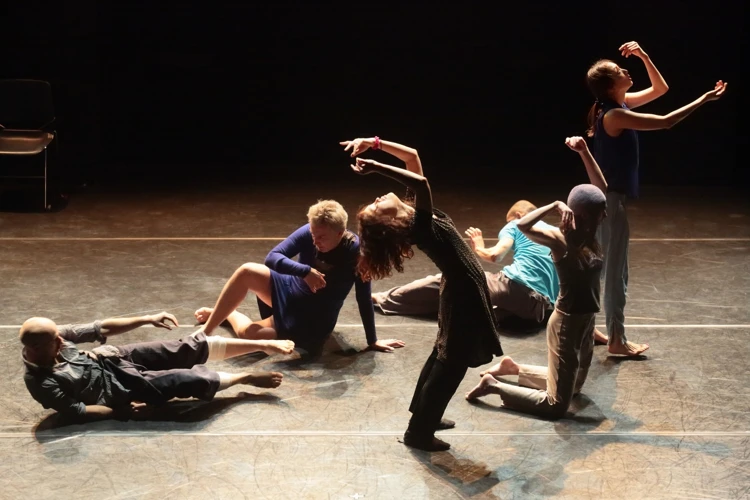Contemporary dance is a unique expression of movement that allows dancers to showcase their creativity and individuality in a way that’s not restricted by traditional dance techniques. One of the key elements that make contemporary dance stand out is improvisation, a technique that offers limitless possibilities for dancers to explore their movements and emotions. However, the role of improvisation in contemporary dance is often misunderstood and seen as chaotic or unstructured. In this article, we’ll explore the importance and benefits of improvisation in dance, the different improvisation techniques used in contemporary dance, and the future of improvisation in the field. Get ready to discover how improvisation can enrich and enhance your dance practice.
Contemporary Dance and Improvisation
Contemporary dance has become a popular form of expression, known for its fluidity and experimentation. While choreography plays a major role in this genre, improvisation has also become a crucial component in creating unique and dynamic performances. As contemporary dance continues to evolve, so does the role of improvisation in shaping its future. To understand the relationship between contemporary dance and improvisation, it is important to explore the origins and evolution of this art form. (You can learn more about the evolution of contemporary dance by following this link.)
Exploring the Importance of Improvisation in Contemporary Dance
Improvisation plays a significant role in contemporary dance. Although choreographed dance forms dominate the contemporary dance scene, improvisation allows for a unique experience that cannot be achieved through a pre-planned routine. Improvisation in contemporary dance is important because it allows dancers to connect with their inner selves, move spontaneously, and express ideas that may not be possible in a choreographed piece. Improvisation can enhance the creativity of a dancer and allow for unique and organic movements to emerge.
Through improvisation in contemporary dance, a dancer has the opportunity to explore their body’s capabilities, which can lead to new types of movements and fundamentally challenge the dancer’s world-view. Similarly, improvisation can be a way for dancers to break out of their own habits and move in ways that they may not have thought to try before.
Improvisation can also be a way to bridge the gap between choreographed dances and freestyle movements. It allows for the dancer to find a balance between structure and spontaneity, which can often be the missing ingredient in a choreographed dance routine. Through improvisation, a performer can develop their own style while still following the framework that has been set out for them.
Improvisation can foster a sense of community among dancing partners. It allows for a more intimate and empathetic relationship to develop, one in which the dancers must rely on each other for support and communication. Improvisation in contemporary dance has been known to promote trust, cooperation, and communication among dancers, which can ultimately improve the quality of the performance. It can enhance the connection between dancers and their audience, making the performance more engaging to watch.
Improvisation is a vital component of contemporary dance as it allows for dancers to explore their creativity, connect with their bodies, and build trust and communication among their peers. Through allowing space for spontaneity in addition to choreographed routines, the dancer has the potential to create truly original movements and enhance the level of engagement of a performance.
The Benefits of Improvisation in Dance

As contemporary dance continues to evolve, improvisation has become an increasingly important aspect of the art form. While some may view improvisation simply as a tool for generating movement, it also offers a wide range of benefits for dancers. Improvisation allows for creative freedom and individuality, enhances decision-making skills, develops trust and communication, and integrates emotion into dance performances. But how exactly do these benefits come into play, and what improvisation techniques are commonly used in contemporary dance? In this section, we will explore the answers to these questions and more. For those interested in the contemporary dance scene, it is important to understand the role of improvisation in the art form. You can also check out our list of 10 contemporary dancers to know or our article on the rise of contemporary dance in popular culture to learn more about the art form’s history and evolution.
1. Creative Freedom and Individuality
Creative freedom and individuality are two essential aspects of contemporary dance that are enhanced through improvisation. When a dancer is given the freedom to improvise, they are able to bring their unique personality and interpretation to the dance. According to an article on Explore Music, contemporary dance stands apart from other dance styles in its emphasis on the individual dancer’s self-expression.
Improvisation offers dancers the opportunity to experiment with movements and combinations that are specific to their personal style. As noted in Contemporary Dance Techniques, this can also be a way for dancers to break out of their comfort zone and explore new ways of moving. By embracing their individuality and improvising movements that feel natural to their bodies, dancers can create something truly unique and original.
Improvisation allows dancers to manipulate and interpret the choreography in ways that add depth to the performance. As described in an analysis of Pina Bausch’s work, improvisation is a way for dancers to take a concept and interpret it through their own unique lens, breathing life into potentially abstract ideas.
In contrast to more traditional dance styles, contemporary dance encourages dancers to approach movement in a spontaneous and freeform way. It is through this improvisation that the dancer’s innermost creativity and artistic expression can truly shine. As a result, improvisation is a fundamental aspect of developing not only as a dancer but also as an individual.
2. Enhanced Decision Making Skills
Enhanced Decision Making Skills in Improvisation in Contemporary Dance
Improvisation in Contemporary Dance is not just about creating something on the spot, it is also about making decisions while in the moment. This enhances an individual’s decision-making abilities and helps them to make quick and conscious choices.
Improvisation improves decision-making skills: When a dancer improvises, they are required to make decisions on the spot. Without the help of a choreographer, they need to be conscious of their movements and make decisions in real-time. The dancer needs to be aware of where their body is in the space and make decisions about what move they will perform next. As a result, improvisation promotes quick thinking and decision-making.
Promotes risk-taking: Improvisation in contemporary dance allows dancers to take risks in performance. They get to try out new steps or movements which they may not have done before. This allows them to break away from the usual routine and do something new.
Helps the dancer to become more versatile: Through improvisation, a dancer can explore different styles and techniques, which ultimately makes them more versatile. The dancer gets to try out various ways of moving their body, and this improves their overall dancing abilities.
| Decision Making Skills | How Improvisation Can Help |
|---|---|
| Quick Thinking | Improvisation promotes quick thinking and decision-making as dancers need to make decisions in real-time. |
| Risk-Taking | Improvisation allows dancers to take risks in their performance, which can ultimately help them become better performers. |
| Versatility | Improvisation allows dancers to explore different styles and techniques, thus improving their overall dancing abilities and versatility. |
Improvisation in Contemporary Dance is a valuable tool that not only promotes creativity but also enhances decision-making skills. By allowing dancers to take risks, explore different techniques and styles, and improve their overall versatility, improvisation is becoming increasingly important in contemporary dance.
Technology has had a significant impact on the Contemporary Dance world relating to improvisation, playing an increasingly significant role in the development of new techniques and methods of incorporating improvisation into performance. The integration of technology and improvisation is one of the most exciting areas of growth for Contemporary Dance, and it will be fascinating to see how it develops in the coming years.
3. Developing Trust and Communication
Developing trust and communication is an essential aspect of improvisation in contemporary dance. When dancers improvise, they rely heavily on communication and trust with their dance partners to create a seamless and cohesive performance. Trust-building exercises such as partner work, physical exercises, and games allow dancers to become more comfortable and familiar with one another. These exercises help them to understand their partner’s strengths and weaknesses, allowing them to adapt their movements accordingly.
Communication is also a significant factor in improvisation, as dancers must communicate their movements and intentions to their partners effectively. This communication helps dancers to synchronize their movements and create a fluid performance. Additionally, dancers can use nonverbal communication such as eye contact and body language to communicate with their partners.
Improvisation in contemporary dance also helps dancers to develop trust and communication with themselves. By pushing their personal boundaries and exploring new movements, dancers learn to trust their instincts and make quick decisions. This self-awareness and trust-building lead to more confident and creative performances.
Improvisation in dance can also help develop these skills outside of the dance studio, as the lessons of trust and communication carry over into other aspects of life. The ability to trust others and communicate effectively is essential in all relationships and can benefit individuals in their personal and professional lives.
Improvisation in contemporary dance plays a vital role in developing trust and communication skills among dancers. These skills not only benefit dancers during performances but also carry over into their personal and professional lives.
4. Integrating Emotion in Dance
Emotion is a crucial aspect of contemporary dance, and integrating it into a performance can create a powerful and moving experience for both the dancer and audience. Improvisation provides a unique opportunity for dancers to explore and express their emotions in new and unexpected ways. Through improvisation, dancers can tap into their inner thoughts and feelings, and express them through movement.
1. Authenticity: Improvisation allows dancers to express their true emotions in a way that feels authentic and genuine. Rather than relying on pre-choreographed movements or gestures, improvisation allows for a spontaneity that can be impossible to capture in a rigid routine. This spontaneity can bring a sense of vulnerability and rawness to a performance, which can be incredibly powerful and moving to watch.
2. Exploration: Improvisation provides a unique opportunity for dancers to explore and experiment with different emotions and physical expressions. Through improvisation, they can tap into new emotions and find movements that express those feelings in ways they may not have thought of before. This exploration can lead to new discoveries about themselves and their art, and it can also help them to create more nuanced and complex performances.
3. Connection: When dancers are truly in the moment and allowing themselves to be vulnerable through improvisation, they can create a deep and meaningful connection with their audience. This connection can be felt as the audience is drawn into the emotion and energy of the performance, and it can create a sense of shared experience between the dancers and viewers.
4. Freedom: By integrating emotion into their improvisation, dancers can experience a sense of freedom and release that they may not experience in other styles of dance. Because they are not confined to pre-choreographed movements or sequences, they can allow their bodies to respond organically to the emotions they are feeling in the moment. This freedom can be exhilarating and can help dancers to feel more connected to their bodies and their art.
The integration of emotion into improvisation is an important aspect of contemporary dance. It allows dancers to express themselves authentically, explore new emotions and movements, connect with audiences, and experience a sense of freedom that can be difficult to find in other styles of dance. By embracing improvisation as a tool for emotional expression, dancers can create performances that are truly unique, powerful, and moving.
Contemporary dance offers a unique platform for dancers to explore improvisation as a means of expressing emotion. Unlike more traditional forms of dance, contemporary dance emphasizes the use of emotion and personal expression, making it the perfect style for incorporating improvisation.
Improvisation techniques used in Contemporary Dance

Dancers often use various techniques to explore improvisation in contemporary dance. These methods can aid in the creation of unique dance movements, allowing dancers to express themselves more authentically. Improvisational techniques used in contemporary dance can be divided into different categories, each with its own unique focus and approach. Let’s explore these techniques and discover how they contribute to the development of contemporary dance movements.
1. Contact Improvisation
One of the most popular improvisation techniques used in contemporary dance is Contact Improvisation. This technique was developed in the 1970s by choreographer Steve Paxton and emphasizes the communication between two or more dancers through physical touch.
In Contact Improvisation, dancers rely on each other’s body weight, momentum, and balance to create fluid movements that are spontaneous and unpredictable. The technique often involves one dancer allowing their body to fall, roll, and spiral, while the other dancer(s) respond with appropriate movements to support and interact with the falling body.
To further understand Contact Improvisation, take a look at the table below:
| Key Characteristics | Benefits |
| Physical contact between dancers | – Fosters trust and communication – Enhances body awareness and sensitivity |
| Emphasis on momentum and weight sharing | – Improves coordination and balance – Allows for creative exploration in movement |
| Spontaneous and unpredictable | – Encourages dancers to be present in the moment – Develops adaptability and responsiveness |
Contact Improvisation is an incredibly dynamic and engaging technique that allows dancers to fully explore their physical capabilities while fostering trust and communication between individuals. Its emphasis on unpredictable movements and physical touch brings a raw and organic energy to contemporary dance performances.
2. Site-Specific Improvisation
Site-specific improvisation in contemporary dance refers to performances that are created and performed in a specific location, such as a park or museum. This improvisation style often incorporates the surroundings and utilizes them as unique and integral components of the dance.
The Benefits of Site-Specific Improvisation
Site-specific improvisation presents a range of benefits for dancers and their audience. Firstly, it encourages dancers to be more observant of their environment and to immerse themselves in it. This helps in developing awareness and sensitivity to the space and the objects present within it, thereby allowing them to use these elements to their advantage while improvising.
Additionally, site-specific improvisation allows for a unique and personalized perspective for each dancer and their audience. This is because each location and environment is different, and so the way in which each dancer interacts with it will be different too. As a result, it promotes individuality and creativity for the dancer, and an immersive and engaging experience for the audience.
Techniques used in Site-Specific Improvisation
Some techniques commonly used in site-specific improvisation include:
| Technique | Description |
|---|---|
| Site Analysis | Examining and analyzing the environment and elements present within it to understand how to incorporate them into the performance. |
| Dancing with Objects | Using the objects around the site as props, or in some cases, as the focal point of the dance. |
| Exploring Levels | Using the levels within the site, such as climbing steps, dancing on a raised platform, or crawling on the ground, to bring a unique dynamic range to the performance. |
Site-specific improvisation is a dynamic and exciting form of contemporary dance, as it allows for dancers to connect with their environment in a unique and personalized way. Additionally, it offers audiences a one-of-a-kind experience, as each performance is catered to and influenced by their specific surroundings.
3. Structured Improvisation
Structured improvisation is another technique used in contemporary dance that involves a set of guidelines or rules to follow while improvising. The purpose of structured improvisation is to bring more intention and focus to the improvisational process while still allowing for creative freedom.
One example of structured improvisation is the use of prompts or cues provided by the choreographer or dancer. These prompts could be a word, gesture, or movement that serves as a starting point for the improvisation. The dancer then builds on this initial prompt, using their own interpretation and movement vocabulary. This technique is often used in collaborative choreography to create a sense of cohesion and unity among the dancers.
Another example of structured improvisation is the use of specific movement tasks or parameters. This can include instructions such as “only use your arms”, “move in slow motion”, or “respond to the music”. Structured improvisation with movement tasks helps to challenge the dancer and expand their movement vocabulary while still providing a focus for the improvisation.
Structured improvisation can also be used as a tool for improvisational composition. The choreographer may provide specific guidelines for the dancers to follow, such as a certain sequence of movements or a set amount of time for each movement phrase. The dancers then have creative freedom within these guidelines, which can result in a unique and dynamic dance piece.
Overall, structured improvisation provides a balance between creative freedom and intentional focus in the improvisational process, which can lead to interesting and compelling dance performances.
| Pros | Cons |
| — | — |
| Provides focus and intention in improvisation | Can limit creative freedom |
| Can create a sense of unity in collaborative choreography | May be challenging for inexperienced dancers |
| Challenges dancers to expand their movement vocabulary | Requires clear guidelines and communication from the choreographer |
Improvisation in Choreography

Choreography is the creation of dance sequences and movements that convey a message or tell a story to the audience. Traditionally, choreographers would pre-plan every step of the dance performance and the dance would be executed exactly as rehearsed. However, as contemporary dance evolved, choreographers started incorporating improvisation into their dance routines.
Why is improvisation important in choreography?
Improvisation brings an element of surprise and spontaneity to dance performances, making them unique and unpredictable. It allows dancers to explore movement possibilities that they may not have considered before, making the performance more interesting and captivating. Improvisation also allows dancers to convey their own individuality and express their emotions through the movements they create, adding a personal touch to the performance.
How is improvisation incorporated into choreography?
Often, choreographers will create a rough framework for the dance piece and then allow the dancers to improvise within that framework. This can be done by giving the dancers a certain set of rules or guidelines to follow, such as specific movements, rhythms, or emotions to convey. Alternatively, dancers can be given complete freedom to interpret the framework as they wish, allowing for a truly unique and personal performance.
What are the challenges of incorporating improvisation into choreography?
One of the main challenges of incorporating improvisation into choreography is balancing the element of spontaneity with a cohesive and well-structured dance piece. Improvisation can become chaotic if not properly guided or if the dancers are not properly trained in improvisation techniques. Additionally, incorporating improvisation into a group performance can be difficult, as each dancer may interpret the framework differently and struggle to create a cohesive dance piece.
What are the benefits of incorporating improvisation into choreography?
Incorporating improvisation into choreography can bring a sense of authenticity and individuality to dance performances. It allows dancers to fully express themselves and creates a sense of connection between the performer and the audience. It can also challenge dancers to think creatively and expand their movement vocabulary, leading to growth and development in their craft.
Improvisation in choreography can add an exciting and unique element to contemporary dance performances, allowing for a truly authentic and personal experience for both the dancers and the audience.
Expert Tips on Improvisation in Contemporary Dance

When it comes to improvisation in contemporary dance, expert tips can be incredibly valuable for both novice and experienced dancers alike. Some of the most important tips to keep in mind include:
1. Embrace Your Individuality: One of the key benefits of improvisation in dance is the opportunity to showcase your unique movement style and personality. Don’t be afraid to let your individuality shine through when exploring different improvisation techniques.
2. Stay Open to New Possibilities: In improvisation, it’s essential to stay open to new ideas and movements that may arise in the moment. Resist the urge to plan out every move in advance and allow yourself to be inspired by the music, your surroundings, and the other dancers in the space.
3. Focus on Quality of Movement: While it can be easy to get caught up in the excitement of improvisation, it’s important to remember the importance of quality of movement. Focus on maintaining a strong posture, executing movements with intention, and breathing deeply throughout the improvisation process.
4. Practice Active Listening: Improvisation is a collaborative process, and it’s essential to practice active listening in order to truly connect with the other dancers in the space. Pay attention to the music, other dancers’ movements, and shifts in energy to create a cohesive and dynamic improvisation experience.
5. Embrace Moments of Vulnerability: Improvisation can be a deeply vulnerable experience, as it requires stepping outside of one’s comfort zone and trusting in the process. Embrace moments of vulnerability and use them as an opportunity to deepen your connection with yourself, your fellow dancers, and the audience.
By keeping these expert tips in mind, dancers can enhance their improvisation skills and create truly memorable performances that showcase their unique movement style and personality.
Improvisation and Technology

When we think of improvisation in dance, we may picture dancers moving freely in a studio, reacting to each other in the moment. But what happens when technology is added to the mix?
Technology has the potential to enhance and transform the practice of improvisation in contemporary dance. For example, motion sensors and virtual reality can be used to create immersive and interactive experiences for both the performers and the audience. In this way, the performance becomes a collaborative and evolving experience, with technology serving as a co-creator.
Video technology is also commonly used in improvised performances, allowing performers to watch and respond to footage of themselves in real time. This approach can help dancers refine their improvisational skills and create more cohesive and dynamic performances.
However, the use of technology also raises questions about authenticity and spontaneity in improvisation. When a performance is partially or entirely predetermined by technology, does this still qualify as improvisation? Some argue that the nature of improvisation lies in the immediate and unplanned responses of the performers, while others see technology as simply another tool for artistic expression.
Regardless of one’s stance on the use of technology in improvisational dance, it is clear that technology will continue to play a role in the evolution of this art form. As the boundaries between mediums continue to blur and technological advancements become more sophisticated, exciting new possibilities for improvisation and dance are sure to emerge.
The Future of Improvisation in Contemporary Dance
As the world of dance continues to evolve, the future of improvisation in contemporary dance looks promising. Improvisation has already become an integral part of contemporary dance and is expected to further strengthen its position in the coming years.
Collaboration with Technology
One of the exciting areas where improvisation in contemporary dance is expected to grow is in collaboration with technology. With the advancement of technology, dancers are now exploring new ways to integrate it into their performances. From motion sensors to augmented reality, technology is opening up endless possibilities for dancers to create improvised performances that are even more engaging and interactive for their audience.
Creative Innovations
As improvisation becomes more prevalent in contemporary dance, choreographers and dancers are expected to continue to create new and innovative techniques and forms. One exciting trend emerging in this space is the growing use of structured improvisation. This form of improvisation involves setting parameters for dancers to work with, such as specific music or movement patterns, encouraging them to think creatively within those parameters.
Increased Awareness of the Value of Improvisation
In recent years, there has been an increased awareness of the value of improvisation in contemporary dance. Dancers and choreographers are recognizing the importance of improvisation in developing their creativity and individuality as well as in building their relationship with the audience. This recognition is expected to drive the growth of improvisation in contemporary dance as more and more dancers embrace it in their work.
Inclusivity and Diversity
The future of improvisation in contemporary dance is also expected to be more inclusive and diverse than ever before. Improvisation has the power to bring diverse dancers together, encouraging them to work collaboratively and learn from each other’s unique styles and perspectives. This diversity can lead to more innovative and dynamic performances that are not limited by any one culture or tradition.
The future of improvisation in contemporary dance is both exciting and full of possibilities. As technology advances and the value of improvisation becomes increasingly recognized, we are likely to see new and innovative forms of improvisation emerge. Moreover inclusivity and diversity are also set to play a significant role in shaping the future of improvisation. This trend can lead to a more creative, collaborative, and engaging world of contemporary dance, where dancers can express themselves more fully and audiences can experience the magic of improvisation in new and exciting ways.
Conclusion
After exploring the role of improvisation in contemporary dance, it is clear that it plays a crucial role in the art form. Improvisation allows for the dancers to express themselves in a unique and individual way, while also promoting trust and communication within a group. Furthermore, improvisation offers a creative freedom that is absent in more structured forms of dance, giving dancers the ability to incorporate their own emotions and experiences into their movement.
Through various techniques like Contact Improvisation and Site-Specific Improvisation, dancers are able to push the boundaries of their creativity and challenge themselves both physically and mentally. Even in choreography, improvisation can be a valuable tool for choreographers to create unique and innovative movements that bring their vision to life.
As technology continues to evolve, the integration of improvisation and technology has become a growing trend in contemporary dance. With the use of sensors, motion capture, and other technological advancements, dancers are able to add an entire new dimension to their improvisation and performances.
Overall, the future of improvisation in contemporary dance is bright. It offers endless possibilities for dancers to express themselves and push the boundaries of the art form. Whether it be through individual improvisation or collaborative improvisation within a group, the benefits and importance of improvisation in contemporary dance cannot be denied. It is an essential part of the creative process that allows dancers to truly bring their unique vision to life on stage.
Preguntas frecuentes
What is improvisation in contemporary dance?
Improvisation in contemporary dance is the act of creating movement spontaneously, without pre-planning or choreography.
Why is improvisation important in contemporary dance?
Improvisation allows dancers to express themselves freely and create unique movements, leading to greater creativity and authenticity in their performances.
What are some benefits of practicing improvisation in dance?
Practicing improvisation in dance can lead to increased creativity, enhanced decision-making skills, improved communication and trust among dancers, and the ability to integrate emotion into performances.
What are some popular improvisation techniques used in contemporary dance?
Popular improvisation techniques include contact improvisation, site-specific improvisation, and structured improvisation.
How do dancers use improvisation in choreography?
Dancers may use improvisation to create new movements that they later incorporate into choreography, or to add spontaneous elements to pre-planned choreography.
Can beginners learn to improvise in contemporary dance?
Yes, beginners can learn to improvise in contemporary dance by starting with simple exercises and gradually building their skills over time.
How can technology be used in improvisation in dance?
Technology can be used to enhance improvisation in dance by providing sound and visual cues for dancers to respond to, or by using motion capture technology to create interactive performances.
What is the future of improvisation in contemporary dance?
The future of improvisation in contemporary dance is likely to involve continued experimentation with new techniques and technologies, as well as greater emphasis on collaboration and cross-disciplinary work.
What qualities are important for dancers practicing improvisation?
Important qualities for dancers practicing improvisation include creativity, flexibility, openness to new experiences, and the ability to work well with others.
Can improvisation be used in other forms of dance besides contemporary?
Yes, improvisation can be used in a variety of dance styles, including jazz, hip hop, and even classical ballet.

